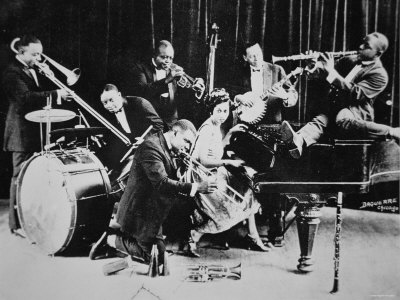Jazz came into the spotlight in the roaring twenties, when America experienced peak period of music, dance, and revolutionary fashions. Jazz was a way of dancing and a type of music, both stemming from African American traditions in the South.
Former form of jazz can be traced back to 1700s, the times when African American people were still slaves. Living in harsh conditions, slaves created their own type of music; while working, a leader of a crew called out a line, and the rest of the crew responded to the call. These slave work songs based on "call and response" became the very basic foundation of jazz.
During 1800s, the large influx of immigrants from Europe added variety to this foundation. European immigrants painted their style on the sketch of African American rhythmic music to create "ragtime" music; Scott Joplin was one of the composer who put all these various elements into ragtime music.

Right before 1920s, New Orleans produced a profusion of jazz artists like Joe 'King' Oliver, Louis Armstrong, and The New Orleans Rhythm Kings. In the 1920s, as people moved from New Orleans to northerns cities where there were lots of new opportunities, jazz started to shine in these cities like New York and Chicago (Yes, that's the city that Carl Sandburg adored). These cities were the places where jazz, though pretty different from the modern, improvisational jazz, started to be defined as an informal, strongly rhythmic music. Among the people who had moved to the northern cities to seek working opportunities, young generations started to enjoy jazz. Public's accessibility to records and radios made jazz even more widely available and popular. Jazz was almost exclusively the genre for young generations, such as flappers who danced their nights away with jazz music.
As I mentioned, Chicago was the garden for flowering jazz music. Though still a segregated city during daytime, Chicago transformed into a heaven of night clubs, pool halls, tattoo parlors, and vaudeville houses where the border between the black and the white smudged out in the night.
No comments:
Post a Comment